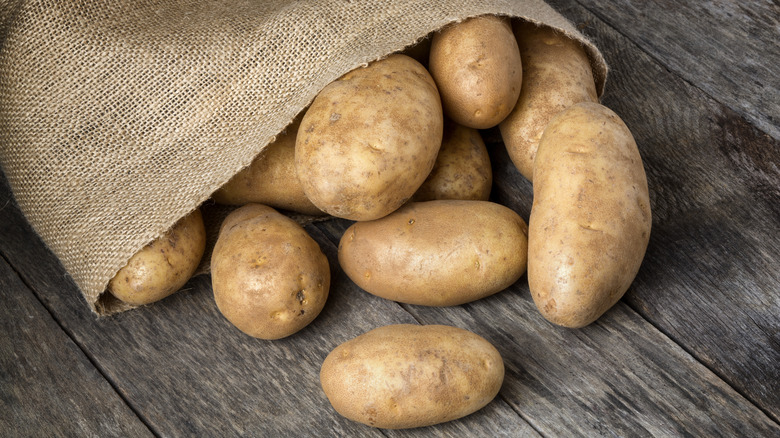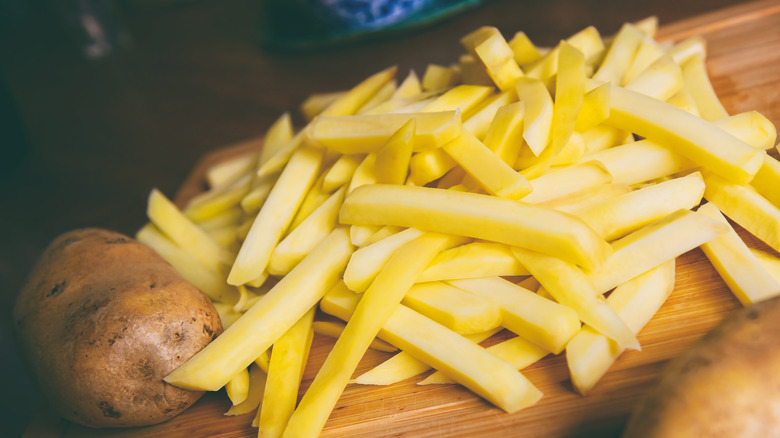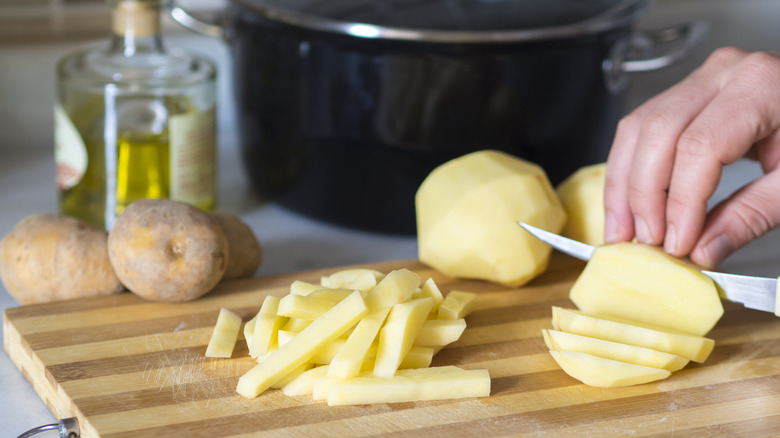The Russet Potato Secret You Should Know Before Cooking
CORRECTION 12/19/22: A previous version of this article identified the farmer who discovered the Russet Burbank potato as Lester Burbank. The farmer's name is Luther Burbank.
Picking the perfect potato for a particular preparation isn't terribly difficult, but it does require an understanding of the properties of the different kinds of potatoes. Experienced cooks know swapping a red-skinned for a russet won't necessarily produce the same results, and, as Potatoes USA points out, there are more than 200 varieties of potatoes sold in the U.S., broken down into seven basic categories: russet, red, white, yellow, blue/purple, fingerling, and petite.
Gardener's Supply Company suggests it's useful to sort spuds into one of two categories: either "moist, waxy" potatoes, which are likely to survive intact when cooked in a soup, or "dry, mealy" potatoes that are better suited for baking, as their flesh falls apart in soup. However, once you've decided you want a dry, mealy russet potato for your dinner, there can be additional complications. Dr. Potato (a fictional creation of the Idaho Potato Commission) points out a problem with our understanding of potatoes, particularly russet potatoes. Dr. Potato sets the stage for the potato quandary, saying, "someone calls into our office and says 'the potato just doesn't cook up like it used to.'"
There are many varieties of russets
Most people don't realize there are a number of different russet potato varieties, and that they can hail from as many as forty different states, explains Dr. Potato. According to Specialty Produce, the Russet Burbank variety is the most popular potato, making up roughly 70% of the American potato market. A Massachusetts farmer named Luther Burbank discovered the variety in the 1870s and was surprised by the productivity of the plant, both in the size and the number of potatoes it produced.
But the earthy, grainy Russet Burbank isn't the only spud in the game. There's the Russet Norkotah, developed by North Dakota State University in 1987, which has a milder, creamier, and less grainy flesh. You might find the early-maturing Blazer Russet, a variety named in 2005 that's similar to the Burbank, but helps bridge supplies before later maturing varieties are ready for harvest.
Ranger Russets, developed jointly by the USDA and the University of Idaho, have a low sugar content and are used mostly for processed potatoes like french fries. The Umatilla Russet, released in 1998, was developed specifically for french fries, as it fries up paler in color and also has less glucose and sucrose than the Russet Burbank. In short, the russet potato secret is that there are a bunch of different kinds of russets, all with unique properties, which explains Dr. Potato's queries. One russet might cook up differently than another because they're supposed to!
How do different russets perform in the kitchen?
All the attributes of different russet varieties may be academically interesting, but the most important question for most cooks is how they'll behave in the kitchen. Dr. Potato explains that for frying, the ideal russet is a variety with low sugar content, as potatoes with more sugar will fry up darker and may even absorb excess oil. For baking, potatoes with more moisture, like the Russet Norkotah, will bake up creamier than the Russet Burbank, which produces the classic fluffy, slightly grainy texture.
Storing potatoes has a big effect on how they perform in the kitchen as well. Potatoes should be stored in a cool, dark place. If they're refrigerated or stored too cold, the starch in your potatoes will convert to sugar, which can make the potato taste too sweet and may cause it to darken too much if you plan to fry it. One tip for better french fries is to blanch cut potatoes in hot water before frying, which will remove sugars from the surface, resulting in the perfect golden color of the ideal french fry.
And how do you even know which variety of potato you've brought home? Dr. Potato comes to the rescue again. Idaho potatoes are required by law to list the variety of potato on the label, but they're the only state with that requirement.


